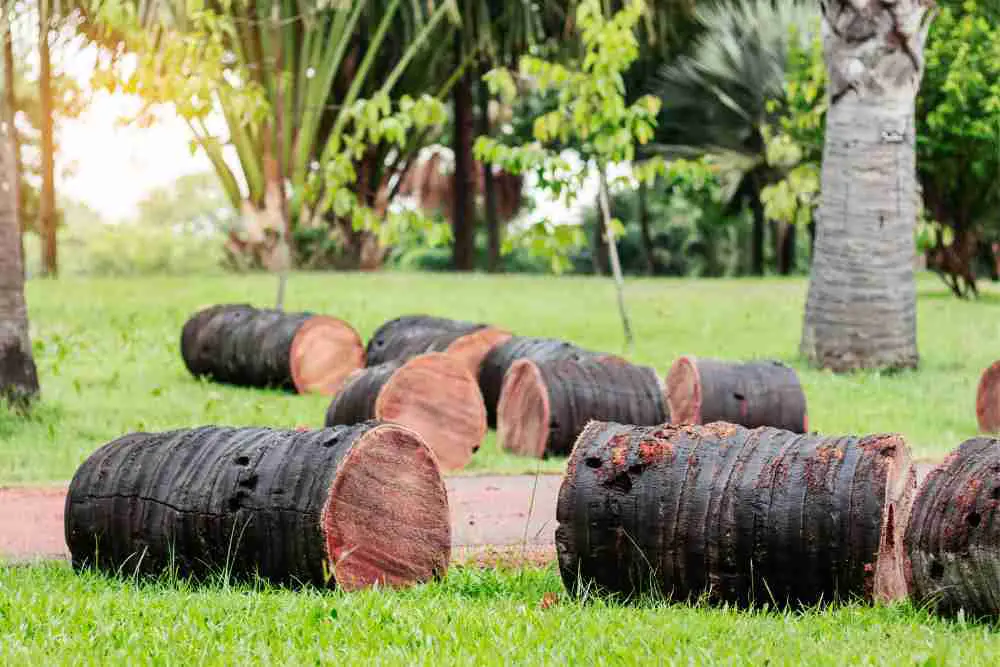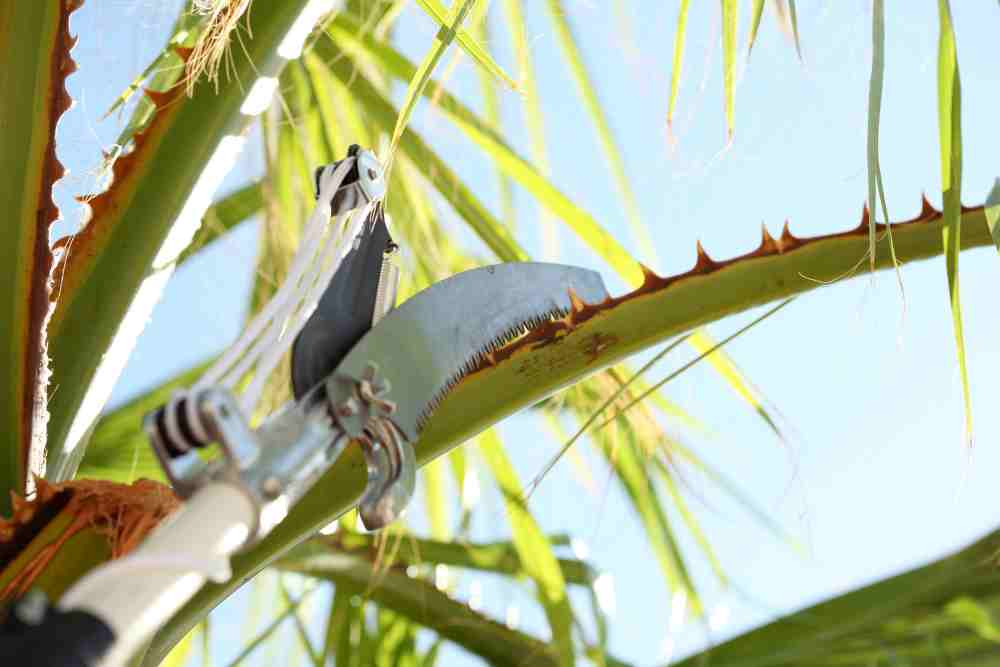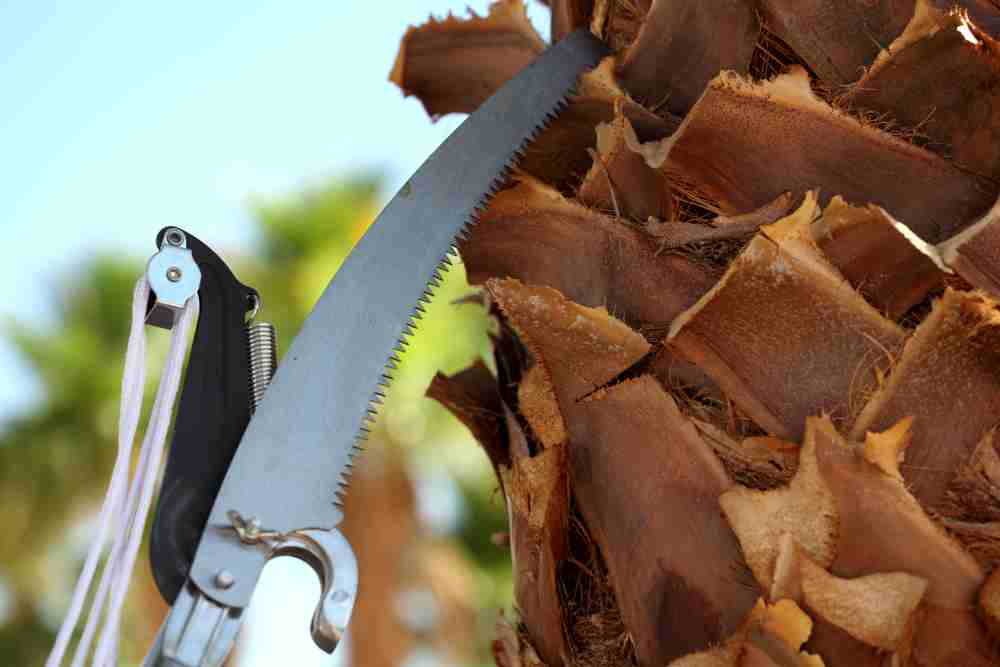Maintaining a palm tree’s health, beauty, and safety requires regular trimming. When done correctly, it promotes the tree’s growth and improves its look. But poor pruning can harm a tree irreparably and even endanger its life.
This manual offers crucial instructions for properly trimming a palm tree. We’ll go through everything you need to know, from deciding when to prune to picking the best tools and methods.
You can protect your palm tree’s health and create a lovely landscape that increases the value of your property by following these rules. Let’s go out on a quest to become experts at trimming palm trees.

What is Palm Tree?
A palm tree is a type of tall, tropical or subtropical tree that belongs to the family Arecaceae (also known as Palmae). These trees are renowned for their distinct appearance, characterized by a long, unbranched trunk with a crown of large, feathery or fan-shaped leaves at the top.
Palm trees are widely distributed across various regions with warm climates, including tropical rainforests, coastal areas, and arid deserts. They are especially common in places like Southeast Asia, the Caribbean, Central and South America, and parts of Africa.
The diverse species of palm trees exhibit a wide range of sizes, leaf shapes, and growth habits. Some palm trees can grow to towering heights of over 100 feet (30 meters), while others remain relatively short and shrub-like.
The leaves, known as fronds, can vary from pinnate (feather-like) to palmate (fan-shaped) and can be used for various purposes such as thatching, weaving, and making handicrafts.
What Things to Consider During Cutting Palm Trees?

Before cutting palm palms, numerous crucial considerations should be taken into account:
Season and Timing
Pick a warm season, such as spring or summer, when it is appropriate to trim. To prevent potential frost damage or stress during storms, don’t cut the tree during the colder months or hurricane season.
The Health of the Tree
The general health of the palm tree should be evaluated. Avoid trimming stressed, diseased, or freshly transplanted trees because pruning may be necessary to allow the tree to recover.
Type of Palm
Every type of palm has a different growth pattern and pruning needs. To make sure you are cutting your palm appropriately, do some research on the particular type you have.
Amount of Trimming Needed
The amount of pruning that is necessary should be determined. To reduce stress and encourage healthy growth, don’t remove too many healthy fronds.
Local Regulations
Check for any municipal limitations or laws that may apply to cutting palm trees in your area. Certain pruning techniques may be subject to regulations or license requirements in some areas.
Recognize the Optimal Trimming Period
Only prune palm trees if necessary. Generally speaking, spring or summer are the optimum times to trim them. When trimming in the winter, the tree may be vulnerable to frost damage.
Avoid trimming during hurricane season because doing so increases the tree’s vulnerability to wind harm.
Examine the needs of the tree
Considerably assess the palm tree’s state and pinpoint the precise regions that need repair before you begin.
Concentrate on removing any fronds that are dead, yellowing, or browning as well as any extra fruit stalks that can impede the tree’s growth.
Regular Maintenance
Keep in mind that trimming palm trees is a continuous procedure. To maintain the tree’s health and aesthetic appeal, check it frequently and prune it as necessary.
You’ll need a collection of necessary tools to prune palm trees safely and effectively if you want to do it right. With the right tools, you can effectively maintain the health, beauty, and safety of the palm tree when pruning in a variety of settings.
How To Trim A Palm Tree?

Maintaining a palm tree’s health, beauty, and safety requires regular trimming. Regular pruning maintains the tree’s health, improves its look, and encourages healthy growth.
However, incorrect trimming can result in permanent harm, weakening the tree and potentially increasing its vulnerability to pests and diseases.
Follow this thorough guideline on palm tree trimming to preserve the health and longevity of your palm tree.
Step-1) Trimming the Fronds
Trimming should begin with the lower hanging fronds. These are typically the oldest and can be decomposing or dead. Avoid cutting into the trunk itself as this can result in infections; instead, cut them near the trunk.
Step-2) Leave a few green fringes
To encourage the tree’s growth, it is imperative to leave a sufficient number of sturdy, green fronds on the tree. Too many leaves taken off at once might shock the tree and prevent it from photosynthesis.
Step-3) Trim Fruit Bunches and Flower Stalks
If your palm tree produces fruit or flowers, think about trimming any overgrown fruit bunches and flower stalks. Some of them can be eliminated to stop the tree from using energy on useless seed production.
Step-4) Prevent clear of “Lion’s Tail” or “Hurricane” Pruning
Avoid the urge to do “hurricane” or “lion’s tail” pruning, which involves removing everything but the top few fronds. The tree becomes weakened as a result of this approach, making storm damage more likely.
Step-5) Remove Diseased or Infected Fronds
To stop the spread of any diseases or pest infestations, carefully clip any fronds that you find and dispose of them far from the tree.
Step-6) Seal Wounds (optional)
While some experts advise using a tree wound sealer to seal pruning wounds, others contend that palms are best suited to letting wounds heal naturally. Apply a wound sealer sparingly if you do so to prevent encasing moisture and potential microorganisms.
What are the tools needed to cut palm trees?

Pruning shears
Pruning shears, also referred to as hand pruners, are excellent for cutting tiny branches and fronds. They give precise cuts on thinner growth and are lightweight and manageable.
Pruning shears come in a variety of sizes, and it’s important to pick ones that feel good in your hand and have sharp blades for precise cuts.
Loppers
Long-handled loppers are useful for reaching thicker branches and fronds that are out of your immediate reach since they have long handles.
They provide more leverage, making it easier for you to chop through thicker and more difficult growth. To ensure efficient trimming, the loppers’ blades must be kept sharp, just like pruning shears.
Pruning Saw
For cutting larger fronds or branches that are too big for pruning shears or loppers, a pruning saw is required. These saws frequently include curved blades, which make it simpler to maneuver around the palm’s organic contour.
The pruning saw’s strong teeth allow for effective cuts on thicker growth without needless harm to the tree.
Pole Saw
A pole saw is a useful instrument for towering palm trees that are difficult to access even with a ladder.
With this device, you may safely prune higher fronds while standing on the ground by combining a pruning saw with an extended handle.
Telescoping handles are an additional feature on some pole saws, increasing their adaptability to various heights.
Safety equipment
Pruning palm trees can be dangerous due to thorns, jagged fronds, and falling debris. Always put on the proper safety gear, such as gloves, goggles, and sometimes a hard hat.
With this equipment, you are protected from potential harm and may concentrate on the current pruning operation.
Climbing Tools (if Need)
To safely get the highest fronds of quite tall palm trees, climbing equipment may be needed. To keep you safe when climbing up and down the tree, you’ll need climbing harnesses, ropes, and other climbing equipment.
FAQs
In which season palm trees should be trimmed?
The warm months, such as spring or summer, are the best times to trim. Avoid cutting during the winter or hurricane season to reduce the risk of frost damage and storm vulnerability.
How do you dispose of palm cuts?
To dispose of palm cuts, use the following actions:
Smaller fronds should be bundled and firmly tied with twine.
Cut bigger fronds and branches into workable sizes.
Put the trimmings in compostable bags or green garbage containers.
For gathering or drop-off arrangements, get in touch with nearby tree removal services or green waste disposal facilities.
Cuttings shouldn’t be dumped in natural regions since they can damage the environment and fuel wildfires.
How much should I trim off the palm tree?
Focus on removing dead, fading, or brown fronds while pruning a palm tree. To maintain the tree’s growth without putting it under stress, leave enough healthy, green fronds. Too many leaves removed all at once might shock the tree and impair its ability to adequately photosynthesize.
How do I deal with infected or diseased fronds?
Carefully prune and remove any afflicted foliage from the palm tree to treat infected or diseased fronds. To stop the spread of pests or illnesses, dispose of the unhealthy or infected fronds far from the tree.
This preventive strategy will contribute to maintaining the health of the tree as a whole and halting the spread of any potential pests to other areas of the palm.